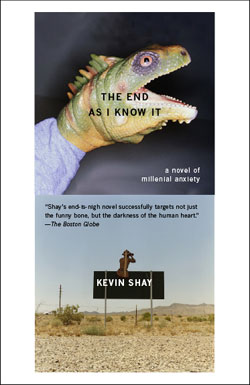In the course of my obsessive self-Googling online travels since the release of The End as I Know It, I’ve come across a number of the book’s bound galleys, or advance reading copies, for sale.
The term “galley” is an artifact from the bygone days of movable type (not to be confused with Movable Type). I can’t speak confidently about the historical usage of “advance (reading) copy” versus “(bound) galley,” but my impression is that they’re generally synonymous these days.
One copy on eBay in particular caught my eye. It was billed as a “SEALED ARC.” The seller, in fact, seems to specialize in these. His store features dozens of “UNREAD NEW CONDITION SEALED IN PLASTIC” ARCs, each listed with the boastful challenge:
If YOU can find another SEALED proof copy let ME know where!
This sounds good, right? I mean, if you happen to be in the market for an advance copy of a book, wouldn’t it make sense to go with a sealed one over an unsealed one?
There’s only one problem. Publishers don’t seal these copies in plastic before sending them out. The galleys of my book certainly weren’t individually wrapped in anything, and I’ve never heard of pre-publication copies of any book being treated this way. In other words, this guy is just getting his hands on advance copies of books, not necessarily unread or even in mint condition, and shrinkwrapping them himself. YOU can’t find another SEALED proof copy because SEALING proof copies is sort of a WEIRD thing to DO.
I should point out that he doesn’t appear to be misrepresenting the books’ condition, nor is he asking or getting large sums for them. But the remainder of the boilerplate listing for each book, even if not strictly misleading about the item itself, paints an interesting picture of the book-editing process.
For those of you who don’t already know, the rarest form of a published collectible is an uncorrected, unedited, advance proof. These hard to find collectible proofs are only sent to editors or reviewers.
Plus bookstores, parents, in-laws, friends, aunts, uncles, and my landlord. And as for their being sent to editors—at least in my case, the text of TEAIKI had already been fully edited, revised, and copyedited by the time the galleys were produced. I’m sure there are non-fiction books, and maybe a handful of novels by perfectionists, that undergo more substantial changes once in galleys, but they’re hardly “unedited.”
These books are sent to editors, the language is cleaned up, the stories are toned down or eliminated entirely.- many of them are written in (not this one) and then many of the copies are destroyed.
Emphasis mine. I don’t think any editor, proofreader, or author would be too happy about having to make corrections, let alone the sort of freewheeling censorship and wholesale rewrites implied here, in the margins of a bound paperback book. I was sent “page proofs,” identical to what went into the galleys but printed on letter-size paper, so I could make any final revisions. And again, by that time the changes were few and very small, and my editor and copyeditor (only one of each) had long since finished their work.
Finally let me stress that because so very few proof copies are made the price on a rare proof (marked and stamped as such with pre-publishing data etc.) can only go through the roof. (A Harry Botter [sic] proof copy recently sold on Ebay for over $1000- the first edition of the same book is still available in bookstores for around $12).
Well, for one thing, the Harry Potter books are (famously) kept under lock and key and relentlessly embargoed to prevent their contents from leaking out before the publication date, so I’m betting there aren’t a lot of galleys floating around in the first place. For another thing, they’re the most popular books in the world. Somehow I don’t see my ARC of, say, Get in the Game by Cal Ripken, Jr. ever fetching a similar price. Despite the value-added shrinkwrap.
Bid now!! Before it’s to late!!
It’s a paperback copy of a novel you can now purchase in hardcover for a few dollars more!! And it has typos!!
 Anchor Books has released the softcover edition of The End as I Know It: A Novel of Millennial Anxiety. It has a great new cover, designed by Helen Yentus.
Anchor Books has released the softcover edition of The End as I Know It: A Novel of Millennial Anxiety. It has a great new cover, designed by Helen Yentus.